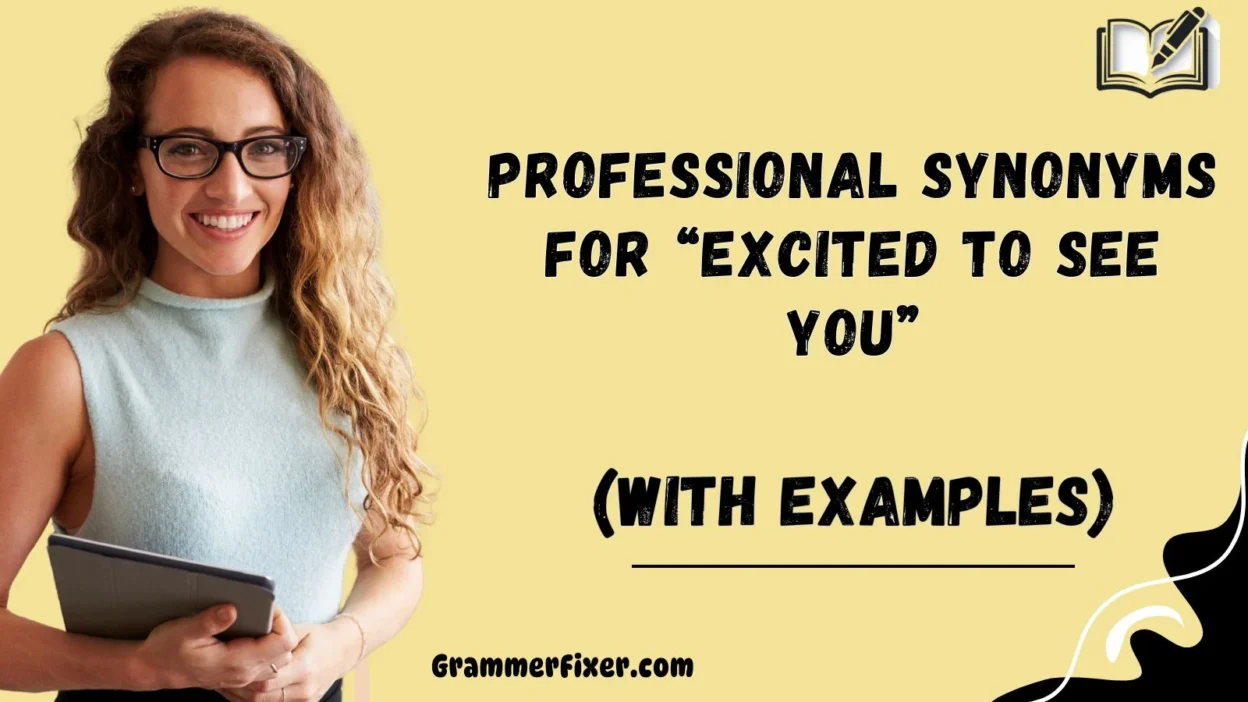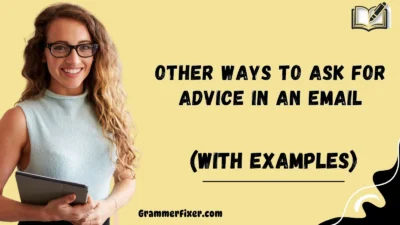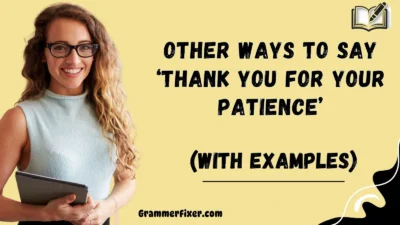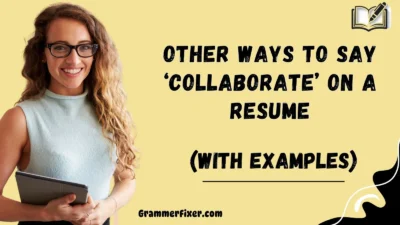Finding the right words to express care and genuine enthusiasm can transform a simple message into something truly meaningful. Whether communicating with a client, colleague, or friend, knowing how to articulate your anticipation helps build rapport, conveys sincerity, and strengthens relationships.
Below, we explore 30 professional alternatives to say “Excited to See You”, complete with examples, context, and tips for effective communication.
What Does “Excited to See You” Mean?
The phrase “Excited to See You” expresses anticipation, happiness, and a positive outlook toward an upcoming interaction. It conveys warmth, personal interest, and enthusiasm, signaling to the recipient that their presence is valued and looked forward to.
When to Use “Excited to See You”?
Use “Excited to See You” in scenarios where your enthusiasm is appropriate:
- Meetings with clients or colleagues where building rapport matters
- Professional networking events
- Reunions with friends or family
- Emails or texts confirming scheduled appointments
It is generally best in semi-formal or casual contexts, avoiding overly informal or insincere tones in strictly formal settings.
Is It Professional/Polite to Say “Excited to See You”?
Yes, with context. The tone must match the situation:
- Professional: Add contextual warmth without being too casual.
- Casual: Works naturally among friends, family, or informal coworkers.
- Avoid in strictly formal emails to executives or external partners unless preceded by proper professional framing.
Pros or Cons
Pros:
- Conveys enthusiasm and positive emotion
- Builds trust, rapport, and connection
- Enhances engagement in interactions
Cons:
- Can feel overly casual or insincere if used improperly
- Might misalign with corporate tone in formal communications
- Excessive use could dilute impact
1. Looking Forward to Seeing You
Meaning: Shows anticipation and interest in an upcoming meeting.
Explanation: A versatile, professional phrase that balances warmth and formality.
Scenario Example: “Dear Julia, I’m looking forward to seeing you at the conference next week.”
Best Use: Professional meetings, networking, or casual business interactions.
Worst Use: Overly casual texts to distant acquaintances or formal executives.
Tone: Polished, friendly, approachable
2. Eager to Meet
Meaning: Expresses genuine enthusiasm about an upcoming encounter.
Explanation: Highlights keen interest and proactive engagement.
Scenario Example: “Hi Michael, I’m eager to meet and discuss your insights on the project.”
Best Use: Interviews, project discussions, client meetings.
Worst Use: Formal or highly reserved corporate emails, may feel pushy.
Tone: Energetic, professional, warm
3. Thrilled to Connect
Meaning: Communicates strong excitement about connecting personally or professionally.
Explanation: Adds a dynamic, engaging flair without being overly informal.
Scenario Example: “Dear Sharon, I’m thrilled to connect and explore potential collaborations.”
Best Use: Networking events, partnership meetings.
Worst Use: Formal official letters or cold introductions with no prior relationship.
Tone: Enthusiastic, personable, approachable
4. Delighted to Meet
Meaning: Shows happiness and respect toward the recipient.
Explanation: A classic, polished option suitable for formal or semi-formal contexts.
Scenario Example: “Mr. Bennett, I’m delighted to meet you at the upcoming conference.”
Best Use: Professional or formal encounters.
Worst Use: Informal texts to close friends, might feel stiff or overly formal.
Tone: Warm, respectful, professional
5. Anxiously Awaiting Our Meeting
Meaning: Expresses strong anticipation and interest.
Explanation: Slightly more intense, can signal high enthusiasm.
Scenario Example: “Dear Andrew, I’m anxiously awaiting our discussion on project updates.”
Best Use: Formal yet warm professional emails, close collaborators.
Worst Use: Casual messages to friends or overly informal contexts, may seem overly dramatic.
Tone: Polished, slightly formal, attentive
6. Keen to Connect
Meaning: Shows desire and genuine interest in building rapport.
Explanation: Conveys both professional interest and friendliness.
Scenario Example: “Hi Suzie, I’m keen to connect and share ideas on the upcoming campaign.”
Best Use: Networking, brainstorming sessions.
Worst Use: Cold emails without context, might feel abrupt or assumptive.
Tone: Warm, approachable, professional
7. Looking Forward to Our Interaction
Meaning: Polite and professional alternative expressing anticipation.
Explanation: Suitable for emails and messages where formal tone is key.
Scenario Example: “Dear Adam, I’m looking forward to our interaction during the workshop.”
Best Use: Formal corporate settings, professional correspondence.
Worst Use: Casual texts or chats with friends, might sound overly stiff.
Tone: Neutral, professional, welcoming
8. Awaiting Our Meeting
Meaning: Neutral, polite, and professional anticipation.
Explanation: Subtle expression of eagerness without casual tone.
Scenario Example: “Dear Charlotte, I am awaiting our meeting scheduled for Monday.”
Best Use: Strictly professional or corporate emails.
Worst Use: Informal texts, messages to friends, or very casual interactions.
Tone: Neutral, respectful, formal
9. Excitedly Anticipating
Meaning: Strong enthusiasm for an upcoming encounter.
Explanation: Highlights energy and engagement in a semi-formal tone.
Scenario Example: “Hi Tyler, I’m excitedly anticipating our video call tomorrow.”
Best Use: Semi-formal emails, texts, or messages to approachable colleagues.
Worst Use: Formal letters or highly reserved corporate communication.
Tone: Energetic, friendly, slightly informal
10. Pumped to Meet
Meaning: Very casual, energetic expression of excitement.
Explanation: Suited for friendly, informal settings or peers.
Scenario Example: “Hey Alex, pumped to meet up and discuss our project ideas!”
Best Use: Informal team chats, friends, peers in casual contexts.
Worst Use: Emails to clients, executives, or formal professional settings; may feel unprofessional.
Tone: Casual, lively, enthusiastic
11. Ready to Meet
Meaning: Shows preparedness and enthusiasm for an upcoming encounter.
Explanation: A concise, professional phrase that conveys both energy and readiness.
Scenario Example: “Hi Samantha, I’m ready to meet and discuss the project timeline.”
Best Use: Team meetings, interviews, collaborative sessions.
Worst Use: Formal emails to high-level executives without prior rapport; may seem too casual.
Tone: Energetic, approachable, professional
12. Delighted at the Prospect
Meaning: Expresses happiness and anticipation for an upcoming event or meeting.
Explanation: Formal and polished; emphasizes sincere interest.
Scenario Example: “Dear Gregory, I am delighted at the prospect of working together on this project.”
Best Use: Professional meetings, networking, formal correspondence.
Worst Use: Informal chats or casual texts; may feel overly stiff.
Tone: Formal, warm, respectful
13. Enlivened by the Opportunity
Meaning: Communicates enthusiasm and motivation for an upcoming interaction.
Explanation: Suggests energy, engagement, and professional positivity.
Scenario Example: “Dear Julia, I am enlivened by the opportunity to discuss your insights during the workshop.”
Best Use: Formal professional emails, presentations, networking events.
Worst Use: Casual texting or informal team chats; may seem too grandiose.
Tone: Formal, polished, energetic
14. Overjoyed to Meet
Meaning: Shows strong happiness and warmth toward an upcoming encounter.
Explanation: Emphasizes genuine excitement while remaining professional in the right context.
Scenario Example: “Dear Andrew, I’m overjoyed to meet you at the annual conference.”
Best Use: Friendly professional interactions, networking, semi-formal events.
Worst Use: Very casual texting to colleagues; may feel exaggerated or insincere.
Tone: Warm, enthusiastic, approachable
15. Enthusiastic About Our Meeting
Meaning: Expresses keen interest and positive anticipation.
Explanation: Suitable for professional emails where energy and engagement are appreciated.
Scenario Example: “Hi Tyler, I’m enthusiastic about our meeting on Monday to review project progress.”
Best Use: Team meetings, client interactions, collaborative projects.
Worst Use: Casual messages to friends; may seem overly formal.
Tone: Professional, positive, encouraging
16. Looking Forward to Catching Up
Meaning: Polite anticipation for a personal or professional reunion.
Explanation: Works well for colleagues, clients, or friends; balances warmth and professionalism.
Scenario Example: “Dear Charlotte, looking forward to catching up during the conference coffee break.”
Best Use: Semi-formal interactions, professional networking, casual professional chats.
Worst Use: Formal correspondence with unfamiliar contacts; may feel too informal.
Tone: Warm, conversational, friendly
17. Thrilled About Our Encounter
Meaning: Expresses high excitement for an upcoming meeting.
Explanation: Adds energy and enthusiasm, suitable for semi-formal professional settings.
Scenario Example: “Hi Suzie, I’m thrilled about our encounter tomorrow to discuss potential collaborations.”
Best Use: Professional networking, semi-formal meetings.
Worst Use: Strictly formal emails; could feel unprofessional.
Tone: Energetic, enthusiastic, friendly
18. Excitedly Looking Ahead
Meaning: Expresses anticipation in a professional and forward-looking way.
Explanation: Highlights eagerness while maintaining politeness and professionalism.
Scenario Example: “Dear Robert, I’m excitedly looking ahead to our strategy session next week.”
Best Use: Project meetings, team updates, professional discussions.
Worst Use: Casual social interactions; may sound too formal.
Tone: Polished, forward-looking, enthusiastic
19. Glad to Connect
Meaning: Friendly and professional expression of pleasure at meeting someone.
Explanation: Neutral, versatile, and widely applicable across corporate settings.
Scenario Example: “Hi Michael, glad to connect and discuss our upcoming collaboration.”
Best Use: Networking, client introductions, team meetings.
Worst Use: Overly formal letters; may feel too casual.
Tone: Friendly, approachable, neutral
20. Eagerly Awaiting
Meaning: Shows strong anticipation for a meeting or discussion.
Explanation: Conveys enthusiasm while remaining professional in tone.
Scenario Example: “Dear Adam, I’m eagerly awaiting our conversation regarding the new project.”
Best Use: Semi-formal professional emails, client follow-ups.
Worst Use: Informal messages to friends; could feel overly intense.
Tone: Polished, energetic, engaged
21. Excited for Our Get-Together
Meaning: Polite, semi-formal expression of excitement for a meeting or meeting-like event.
Explanation: Adds warmth and personal touch to professional interactions.
Scenario Example: “Hi Danni, excited for our get-together tomorrow to review the project plan.”
Best Use: Team lunches, casual professional meetings.
Worst Use: Formal corporate emails to senior executives; may feel informal.
Tone: Warm, friendly, approachable
22. Animated to Meet
Meaning: Shows liveliness and energy toward an upcoming meeting.
Explanation: Adds vivid enthusiasm in semi-formal settings.
Scenario Example: “Hi Andrew, I’m animated to meet and discuss our marketing strategy.”
Best Use: Creative teams, semi-formal collaborations, workshops.
Worst Use: Highly formal emails; could appear unprofessional.
Tone: Energetic, lively, friendly
23. Excited About Our Discussion
Meaning: Expresses anticipation for a conversation or meeting.
Explanation: Professional and versatile; suitable for emails and messages.
Scenario Example: “Dear Sharon, I’m excited about our discussion on new partnership opportunities.”
Best Use: Professional meetings, client calls, team discussions.
Worst Use: Casual texts to friends; may sound overly formal.
Tone: Polished, professional, approachable
24. Pumped for Our Meeting
Meaning: Casual and energetic expression of excitement.
Explanation: Best suited for informal contexts where enthusiasm is welcome.
Scenario Example: “Hey Tyler, pumped for our meeting tomorrow to brainstorm ideas!”
Best Use: Informal team meetings, peer collaborations.
Worst Use: Emails to executives or external clients; may seem unprofessional.
Tone: Casual, lively, energetic
25. Looking Forward to Reconnecting
Meaning: Polite, warm anticipation of meeting someone again.
Explanation: Highlights continuity of relationship and personal connection.
Scenario Example: “Dear Julia, looking forward to reconnecting after our last project discussion.”
Best Use: Professional follow-ups, friendly business interactions.
Worst Use: First-time introductions; may feel inappropriate or premature.
Tone: Warm, professional, personable
26. Excited to Exchange Ideas
Meaning: Shows anticipation for collaborative discussions.
Explanation: Emphasizes engagement and active participation.
Scenario Example: “Hi Suzie, excited to exchange ideas during tomorrow’s brainstorming session.”
Best Use: Team meetings, workshops, professional collaborations.
Worst Use: Casual texts or overly formal emails; could feel out of place.
Tone: Professional, engaged, enthusiastic
27. Enthusiastic to Discuss
Meaning: Conveys strong interest and anticipation for a conversation.
Explanation: Polished phrase suitable for professional emails.
Scenario Example: “Dear Michael, enthusiastic to discuss your insights on the project report.”
Best Use: Client calls, team meetings, professional discussions.
Worst Use: Informal texts to friends; may sound too formal.
Tone: Professional, polite, engaged
28. Excited to Collaborate
Meaning: Expresses anticipation for working together.
Explanation: Appropriate for professional settings emphasizing teamwork.
Scenario Example: “Hi Adam, excited to collaborate on the upcoming marketing campaign.”
Best Use: Project teams, partnership work, cross-department collaboration.
Worst Use: Non-work casual interactions; may feel too formal or rigid.
Tone: Professional, warm, collaborative
29. Looking Forward to Our Exchange
Meaning: Polite and professional expression of anticipation for communication.
Explanation: Versatile and formal enough for corporate communication.
Scenario Example: “Dear Charlotte, looking forward to our exchange on project objectives.”
Best Use: Emails, professional correspondence, client discussions.
Worst Use: Informal texts; may feel stiff or overly formal.
Tone: Professional, neutral, polished
30. Joyful About Our Upcoming Meeting
Meaning: Expresses happiness and anticipation for a scheduled meeting.
Explanation: Combines warmth, professionalism, and positivity.
Scenario Example: “Dear Tyler, joyful about our upcoming meeting to review team goals.”
Best Use: Semi-formal or friendly professional contexts.
Worst Use: Strictly formal corporate emails; may feel too casual or emotional.
Tone: Warm, professional, positive
Conclusion
Finding the perfect way to say “Excited to See You” can make a significant difference in how your message is received. Whether you’re reaching out to a client, colleague, or friend, the words you choose convey warmth, respect, and professionalism. Using the right synonym allows you to express genuine enthusiasm while maintaining the appropriate tone for the situation.



